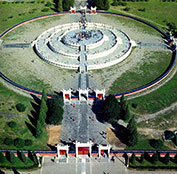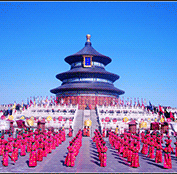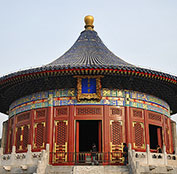1. The Hall of Prayer for Good Harvests
It was used to worship both earth and heaven. The hall is the main building in the compound, a lofty cone-shaped structure with triple eaves. In 1545, it was rebuilt into a magnificent triple-gabled circular building, 36 meters in diameter and 38 meters tall, built on three levels of marble stone base, where the Emperor prayed for good harvests. During the ceremony, the emperor stood on the dragon-and-phoenix marble, delivered a speech and tasted the offering food. The princes stand outside the hall with the band, the dancers and officials standing on both sides.
The roof of the hall is made of blue glazed tiles. The building is not only splendid in outer appearance, but also unique in inner frame. It is completely wooden without nails and walls, only partitions of open lattice windows. The ceiling is painted with fine color drawings. On each wing of the main hall, there are subsidiary halls in which were worshipped the Gods of the Sun, the Moon and the Stars, as well as the Gods of Wind, Rain, Thunder and lightning.
2. The Palace of Abstinence
The Palace of Abstinence was the place where the emperor used to observe abstinence from meat, drink, music, women and state affairs for three days before he conducted the sacrificial rites at the temple. Facing east and located to the southwest of the Altar of Prayer for Good Harvests, the Palace of Abstinence is covered with green tiles symbolizing the emperor’s obedience to heaven. The palace, which is square in shape, covers an area of 40,000 square meters. Inside the palace can be found the Beamless Hall, bed chambers, a belfry, a stone pavilion housing a bronze statue (a symbol of justice and righteousness), and rooms for guards and servants. The palace, with its canonical layout and beautiful environment, is girdled by a double wall and a double moat.

3. The Imperial Vault of Heaven
Built in 1530, in a round shape with a double-eave roof, it was the main hall of the Celestial Treasure House of the Circular Mound Altar, housing the God’s tablets of the emperor’s ancestors to be used at the ceremony of worshipping Heaven. It is located south of the Hall of Prayer for Good Harvests and resembles it, but is smaller.
The vault is surrounded by a smooth circular wall, the Echo Wall which has marvelous acoustic properties. A whisper can travel clearly from one end to your friend’s ear at the other. Come to this site earlier so that you won’t be crowded with tour group. The Imperial Vault is connected to the Hall of Prayer by Red Stairway Bridge, a 360 meter long elevated walkway that slowly ascends from the Vault to the Hall of Prayer.
4. The Circular Mound Altar
It is the altar proper, located south of the Imperial Vault of Heaven, an empty circular platform on three levels of marble stones, each decorated by lavishly carved dragons. Three marble tiers representing Earth, Man and Heaven, is the centre of the World. It is said that an orator’s voice originating from these tiers was magnified and could be heard for miles.
The Circular Altar was where the emperor gave heaven his report. Indeed, the sound of the emperor will be reflected by the guardrail, creating significant resonance, which is supposed to help the prayer communicate with the Heaven. The numbers of various elements of the Altar, including its balusters and steps, are either the sacred number nine or its nonuples. The center of the altar is a round slate called the Heart of Heaven, where the emperor prayed for favorable weather.

In 1998, the Temple of Heaven was listed into the World Heritage List by UNESCO. The committee appraised the temple as "Built in the first half of the 15th century, the Temple of Heaven located in the royal garden is surrounded with ancient pines. The temple, reveals the relationship between the Heaven and Ground in terms of whether overall arrangement or single construction. And this relationship possessed a key position in Chinese ancient university view”.
Admission Fee: CNY 35 (Apr 1st - Oct 31st) CNY 30 (Nov 1st - Mar 31st)
Extra cost of CNY 10 for The Divine Music Administration and The Palace of Abstinence
Opening Hour: Gate:6:00-22:00
The scenic spots inside the Temple of Heaven:
8:00——17:30 (Mar 1st - Jun 30th)
8:00——18:00 (Jul 1st - Oct 31st)
8:00——17:00 (Nov 1st - Feb 28th)
Subway: Take Line 5 to Tiantan Dong Station (The Temple of Heaven East Station), A1 Exit
Bus: Overpass Station (Tianqiao Station): 105; 106; 110; 120; 17; 20; 35; 36; 69; 707; 71;729; 7; 835; 837; 917 Fast; T11; 203; 210; 831; Zhuan 30
Overpass Mall Station: 15
The Temple of Heaven North Station: 106; 110; 34; 35; 36; 687; 6; 707
The Temple of Heaven West Station: 17; 20; 2; 35; 36; 504; 69; 707; 71; 729; 93; T11; Zhuan 30
The Temple of Heaven South Station: 120; 122; 36; 525; 53; 958; T11; T12; T3; 208
Fahua Temple: 116; 25; 34; 35; 36; 39; 41; 43; 525; 60; 684; 685; 687; 6; 707; 723









